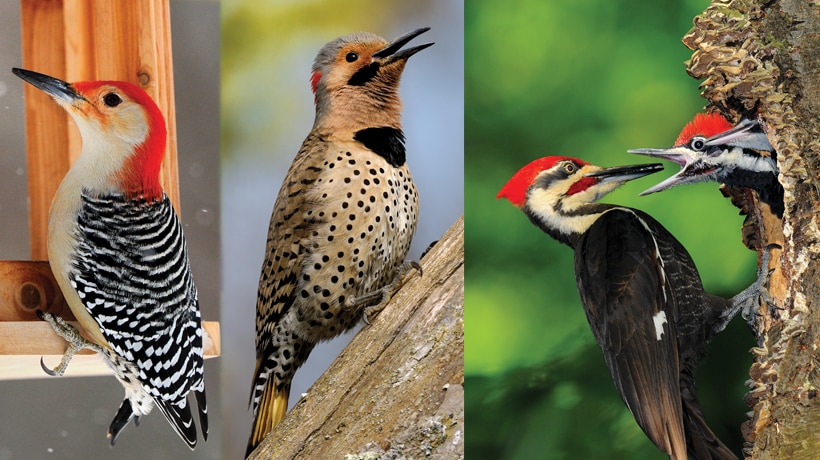Experiencing Woodpeckers in Florida: Variety Diversity and Identification
Experiencing Woodpeckers in Florida: Variety Diversity and Identification
Blog Article
Woodpeckers Unleashed: Discovering the Marvels of These Proficient Tree Climbers
Woodpeckers, with their unique markings and balanced drumming echoing with wooded areas, hold an unique place in the avian globe. Their specialized composition and adjustments enable them to navigate vertical surfaces with unparalleled skill. Their proficiency of tree climbing is simply one aspect of their remarkable actions. As we explore the complex details of woodpeckers' nesting habits, feeding methods, and the ongoing conservation initiatives to protect these exceptional birds, a deeper recognition for their place in nature unfolds.
Composition and Adaptations
When analyzing the anatomy and adaptations of woodpeckers, one can observe exceptional features that allow these birds to prosper in their specialized ecological specific niche. Woodpeckers are furnished with a collection of distinct physiological qualities that assist them in their woodpecking habits. One of one of the most popular features is their strong, chisel-like beak, which is specialized for drilling right into wood to reveal bugs or develop nesting tooth cavities. This beak is supported by strong neck muscular tissues and a highly developed head structure that acts as a shock absorber, allowing woodpeckers to continuously eat trees without creating mind injury. Additionally, woodpeckers have zygodactyl feet, with two toes dealing with forward and 2 dealing with backward, providing a firm hold on tree trunks while they look for food or drum for communication.
In addition, woodpeckers have an unique tongue framework that is long, barbed, and sticky, allowing them to remove insects from gaps in wood. This specific adjustment enables woodpeckers to make use of a food source that is hard to reach to several other bird types. Generally, the composition and adjustments of woodpeckers display the remarkable transformative solutions that have actually enabled these birds to grow in their arboreal habitat.
Drumming Actions
Having discovered the anatomy and adjustments of woodpeckers, the emphasis currently shifts to recognizing their drumming actions, a distinctive element of their communication and territorial display screens. Drumming is an important type of communication amongst woodpeckers, offering several purposes such as establishing regions, drawing in companions, and signaling alarm system. Each woodpecker species has a distinct drumming pattern that helps individuals identify participants of their very own species and identify them from competitors or predators.
Woodpeckers create drumming noises by rapidly pecking on resonant surface areas such as dead trees, energy poles, or perhaps steel things, creating a series of rhythmic beats. The intensity and rate of drumming can vary based upon the purpose; for example, a fast drumming sequence might represent browse this site aggressiveness in the direction of trespassers, while a slower and softer drumming pattern could suggest courtship (Woodpeckers in Florida). Furthermore, woodpeckers might change the frequency and period of their drumming to communicate certain messages effectively
Nesting Routines
Exploring the nesting routines of woodpeckers exposes interesting understandings into their reproductive habits and environment selections. Woodpeckers are recognized for their one-of-a-kind nesting preferences, often excavating cavities in trees to create sheltered spaces for raising their young. These tooth cavities serve not only as a nesting website but likewise as a secure sanctuary from predators and harsh weather condition.
Woodpeckers exhibit a high degree of integrity to their nesting sites, frequently returning to the exact same place every year. This habits highlights the relevance of ideal habitat accessibility for their reproductive success. The option of a nesting website is crucial for woodpeckers, with elements such as tree species, elevation, and degeneration stage playing considerable duties in their decision-making procedure.
Remarkably, some woodpecker varieties are understood to excavate several dental caries within their area, supplying themselves with different nesting alternatives. This strategy might function as a type of insurance against prospective threats or disruptions to their main nesting website.

Feeding Techniques
One of the most unique feeding habits of woodpeckers is drumming, which entails rapid pecking on trees to uncover bugs under the bark. Woodpeckers are likewise known to excavate tooth cavities in trees to gain access find more information to surprise insect larvae or sap. Some types, like the acorn woodpecker, shop nuts in specifically developed openings called granaries.
Conservation Efforts
Amidst the detailed feeding strategies displayed by woodpeckers, the conservation efforts intended at securing these remarkable birds play a crucial duty in preserving their habitats and populaces. Woodpeckers deal with different threats to their survival, including habitat loss due to deforestation, environment adjustment modifying their ecosystems, and collisions with manufactured structures such as buildings and automobiles - Woodpeckers in Florida. Conservationists are proactively working to deal with these challenges and guarantee the lasting health of woodpecker types

Education and public awareness campaigns are likewise crucial components of woodpecker preservation efforts. By elevating awareness about the significance of these birds in keeping healthy woodland environments, preservationists can garner assistance for environment preservation initiatives and promote liable land monitoring methods. With joint initiatives in between researchers, policymakers, and neighborhood communities, we can collaborate to safeguard a future where woodpeckers flourish in their natural habitats.
Conclusion

Report this page